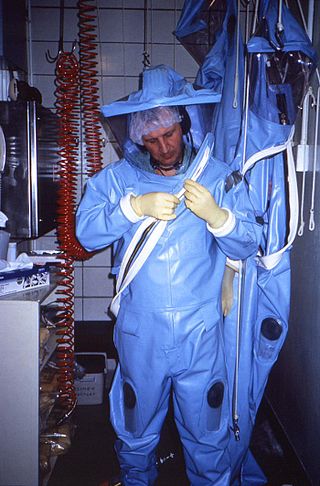Related Research Articles

Biosafety is the prevention of large-scale loss of biological integrity, focusing both on ecology and human health. These prevention mechanisms include the conduction of regular reviews of biosafety in laboratory settings, as well as strict guidelines to follow. Biosafety is used to protect from harmful incidents. Many laboratories handling biohazards employ an ongoing risk management assessment and enforcement process for biosafety. Failures to follow such protocols can lead to increased risk of exposure to biohazards or pathogens. Human error and poor technique contribute to unnecessary exposure and compromise the best safeguards set into place for protection.

A safety data sheet (SDS), material safety data sheet (MSDS), or product safety data sheet (PSDS) is a document that lists information relating to occupational safety and health for the use of various substances and products. SDSs are a widely used system for cataloguing information on chemical species including chemical compounds and chemical mixtures. SDS information may include instructions for the safe use and potential hazards associated with a particular material or product, along with spill-handling procedures. The older MSDS formats could vary from source to source within a country depending on national requirements; however, the newer SDS format is internationally standardized.

Silicosis is a form of occupational lung disease caused by inhalation of crystalline silica dust. It is marked by inflammation and scarring in the form of nodular lesions in the upper lobes of the lungs. It is a type of pneumoconiosis. Silicosis, particularly the acute form, is characterized by shortness of breath, cough, fever, and cyanosis. It may often be misdiagnosed as pulmonary edema, pneumonia, or tuberculosis. Using workplace controls, silicosis is almost always a preventable disease.

Occupational hygiene is the anticipation, recognition, evaluation, control, and confirmation (ARECC) of protection from risks associated with exposures to hazards in, or arising from, the workplace that may result in injury, illness, impairment, or affect the well-being of workers and members of the community. These hazards or stressors are typically divided into the categories biological, chemical, physical, ergonomic and psychosocial. The risk of a health effect from a given stressor is a function of the hazard multiplied by the exposure to the individual or group. For chemicals, the hazard can be understood by the dose response profile most often based on toxicological studies or models. Occupational hygienists work closely with toxicologists for understanding chemical hazards, physicists for physical hazards, and physicians and microbiologists for biological hazards. Environmental and occupational hygienists are considered experts in exposure science and exposure risk management. Depending on an individual's type of job, a hygienist will apply their exposure science expertise for the protection of workers, consumers and/or communities.

Chemical hazards are typical of hazardous chemicals and hazardous materials in general. Exposure to certain chemicals can cause acute or long-term adverse health effects. Chemical hazards are usually classified separately from biological hazards (biohazards). Main classifications of chemical hazards include asphyxiants, corrosives, irritants, sensitizers, carcinogens, mutagens, teratogens, reactants, and flammables. In the workplace, exposure to chemical hazards is a type of occupational hazard. The use of protective personal equipment (PPE) may substantially reduce the risk of damage from contact with hazardous materials.

The Control of Substances Hazardous to Health Regulations 2002 is a United Kingdom Statutory Instrument which states general requirements imposed on employers to protect employees and other persons from the hazards of substances used at work by risk assessment, control of exposure, health surveillance and incident planning. There are also duties on employees to take care of their own exposure to hazardous substances and prohibitions on the import of certain substances into the European Economic Area. The regulations reenacted, with amendments, the Control of Substances Hazardous to Work Regulations 1999 and implement several European Union directives.
An occupational exposure limit is an upper limit on the acceptable concentration of a hazardous substance in workplace air for a particular material or class of materials. It is typically set by competent national authorities and enforced by legislation to protect occupational safety and health. It is an important tool in risk assessment and in the management of activities involving handling of dangerous substances. There are many dangerous substances for which there are no formal occupational exposure limits. In these cases, hazard banding or control banding strategies can be used to ensure safe handling.
Workplace health surveillance or occupational health surveillance (U.S.) is the ongoing systematic collection, analysis, and dissemination of exposure and health data on groups of workers. The Joint ILO/WHO Committee on Occupational Health at its 12th Session in 1995 defined an occupational health surveillance system as "a system which includes a functional capacity for data collection, analysis and dissemination linked to occupational health programmes".
The Institute of Occupational Medicine (IOM) was founded in 1969 by the National Coal Board (NCB) as an independent charity in Edinburgh, UK and retains its charitable purpose and status today. The "Institute" has a subsidiary, IOM Consulting Limited, which became fully independent in 1990 and now celebrates its 25th year within the IOM Group as an independent consultancy and also the commercial part of the IOM organization. It specializes in asbestos surveys and services, occupational hygiene services, nanotechnology safety, laboratory analysis and expert witness consulting services. IOM is therefore one of the UK's major independent "not for profit" centres of science in the fields of environmental health, occupational hygiene and occupational safety.
A short-term exposure limit (STEL) is the acceptable average exposure over a short period of time, usually 15 minutes as long as the time-weighted average is not exceeded.

Hierarchy of hazard control is a system used in industry to prioritize possible interventions to minimize or eliminate exposure to hazards. It is a widely accepted system promoted by numerous safety organizations. This concept is taught to managers in industry, to be promoted as standard practice in the workplace. It has also been used to inform public policy, in fields such as road safety. Various illustrations are used to depict this system, most commonly a triangle.
Engineering controls are strategies designed to protect workers from hazardous conditions by placing a barrier between the worker and the hazard or by removing a hazardous substance through air ventilation. Engineering controls involve a physical change to the workplace itself, rather than relying on workers' behavior or requiring workers to wear protective clothing.

Occupational dust exposure occurs when small particles are generated at the workplace through the disturbance/agitation of rock/mineral, dry grain, timber, fiber, or other material. When these small particles become suspended in the air, they can pose a risk to the health of those who breath in the contaminated air.
The health and safety hazards of nanomaterials include the potential toxicity of various types of nanomaterials, as well as fire and dust explosion hazards. Because nanotechnology is a recent development, the health and safety effects of exposures to nanomaterials, and what levels of exposure may be acceptable, are subjects of ongoing research. Of the possible hazards, inhalation exposure appears to present the most concern, with animal studies showing pulmonary effects such as inflammation, fibrosis, and carcinogenicity for some nanomaterials. Skin contact and ingestion exposure, and dust explosion hazards, are also a concern.
Hazard substitution is a hazard control strategy in which a material or process is replaced with another that is less hazardous. Substitution is the second most effective of the five members of the hierarchy of hazard controls in protecting workers, after elimination. Substitution and elimination are most effective early in the design process, when they may be inexpensive and simple to implement, while for an existing process they may require major changes in equipment and procedures. The concept of prevention through design emphasizes integrating the more effective control methods such as elimination and substitution early in the design phase.

Occupational exposure banding, also known as hazard banding, is a process intended to quickly and accurately assign chemicals into specific categories (bands), each corresponding to a range of exposure concentrations designed to protect worker health. These bands are assigned based on a chemical’s toxicological potency and the adverse health effects associated with exposure to the chemical. The output of this process is an occupational exposure band (OEB). Occupational exposure banding has been used by the pharmaceutical sector and by some major chemical companies over the past several decades to establish exposure control limits or ranges for new or existing chemicals that do not have formal OELs. Furthermore, occupational exposure banding has become an important component of the Hierarchy of Occupational Exposure Limits (OELs).

Engineering controls for nanomaterials are a set of hazard control methods and equipment for workers who interact with nanomaterials. Engineering controls are physical changes to the workplace that isolate workers from hazards, and are considered the most important set of methods for controlling the health and safety hazards of nanomaterials after systems and facilities have been designed.
The hazards of synthetic biology include biosafety hazards to workers and the public, biosecurity hazards stemming from deliberate engineering of organisms to cause harm, and hazards to the environment. The biosafety hazards are similar to those for existing fields of biotechnology, mainly exposure to pathogens and toxic chemicals; however, novel synthetic organisms may have novel risks. For biosecurity, there is concern that synthetic or redesigned organisms could theoretically be used for bioterrorism. Potential biosecurity risks include recreating known pathogens from scratch, engineering existing pathogens to be more dangerous, and engineering microbes to produce harmful biochemicals. Lastly, environmental hazards include adverse effects on biodiversity and ecosystem services, including potential changes to land use resulting from agricultural use of synthetic organisms.
Occupational hazards of fire debris cleanup are the hazards to health and safety of the personnel tasked with clearing the area of debris and combustion products after a conflagration. Once extinguished, fire debris cleanup poses several safety and health risks for workers. Employers responsible for fire debris cleanup and other work in areas damaged or destroyed by fire are generally obliged by occupational safety and health legislation of the relevant national or regional authority to identify and evaluate hazards, correct any unsafe or unhealthy conditions and provide any necessary training and instruction and personal protective equipment to employees to enable them to carry out the task without undue exposure to hazards. Many of the approaches to control risk in occupational settings can be applied to preventing injuries and disease. This type of work can be completed by general construction firms who may not be fully trained specifically for fire safety and on fire hazards.
Workplace exposure monitoring is the monitoring of substances in a workplace that are chemical or biological hazards. It is performed in the context of workplace exposure assessment and risk assessment. Exposure monitoring analyzes hazardous substances in the air or on surfaces of a workplace, and is complementary to biomonitoring, which instead analyzes toxicants or their effects within workers.
References
- ↑ "NIOSH Control Banding". United States National Institute for Occupational Safety and Health. Retrieved 2007-10-15.
- ↑ "CAS Registry". CAS. Retrieved 2024-03-11.
- ↑ "Preventing occupational illnesses through safer chemical management". United States Department of Labor Occupational Safety and Health Administration. Retrieved 2024-03-11.
- ↑ "Qualitative Risk Characterization and Management of Occupational Hazards: Control Banding" (PDF). United States National Institute for Occupational Safety and Health. 2009. doi:10.26616/NIOSHPUB2009152 . Retrieved 2024-03-11.
- ↑ "Risk Assessment for Occupational Dermal Exposure to Chemicals". Instituto Nacional de Seguridad y Salud en el Trabajo. Retrieved 2024-03-11.
- ↑ "Respirable crystalline silica". United States Occupational Safety and Health Administration. Retrieved 2024-03-11.
- ↑ "Recognizing the Biosafety Levels". Centers for Disease Control and Prevention. April 16, 2024.
- ↑ Naumann, B. "Control Banding in the Pharmaceutical Industry" (PDF). Archived from the original (PDF) on October 1, 2009. Retrieved October 16, 2009.
- ↑ Naumann, B. "Control Banding in the Pharmaceutical Industry" (PDF). Archived from the original (PDF) on October 1, 2009. Retrieved October 16, 2009.